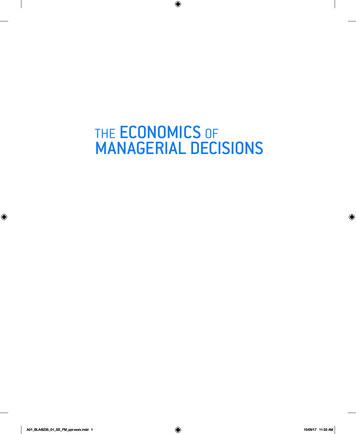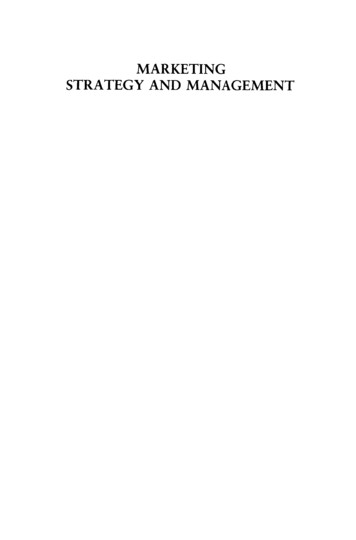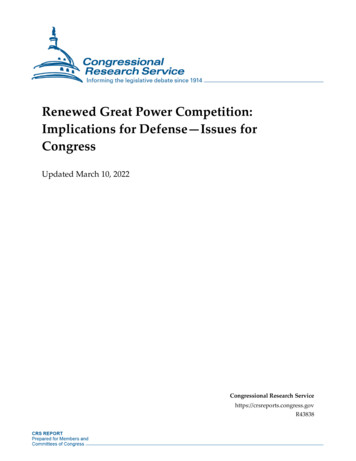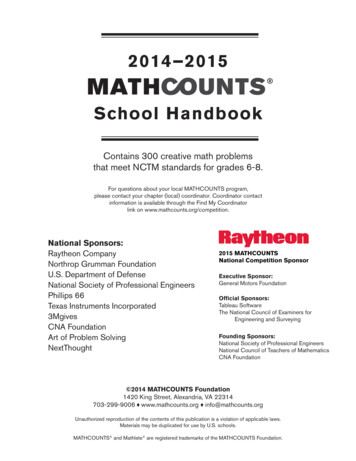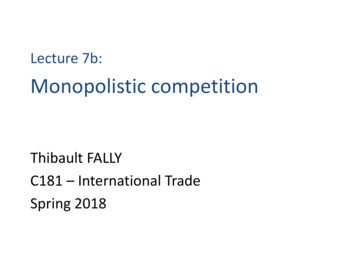
Transcription
Lecture 7b:Monopolistic competitionThibault FALLYC181 – International TradeSpring 2018
2- Monopolistic Competition“Monopolistic competition” Firms don’t take their price as given Firms account for how their production affects prices But take the price of their competitors as given Greatly simplifies equilibrium “Brands” in an almost a competitive environment
2- Monopolistic CompetitionAssumptions of the model of monopolistic competition:Assumption 1: Firms produce using a technology withincreasing returns to scale. There is a constant marginal cost MC c There is a fixed cost F 0
2- Monopolistic CompetitionAssumptions of the model of monopolistic competition:Assumption 2: Firms produce differentiated goods Each firm faces a downward-sloping demand curvefor its product and has some control its priceAssumption 3: There are “many” firms in the industry Firms take the average price across firms as given
2- Monopolistic CompetitionAssumptions of the model of monopolistic competition:Demand:Q S . 1 / n b ( P P ) S: total industry output (assumed fixed) n: number of firms Q: quantity produced by each firm b: sensitivity of demand to prices
2- Monopolistic CompetitionAssumptions of the model of monopolistic competition:Assumption 4: Because firms can enter and exit theindustry freely, profits are zero in the long run. Firms will enter as long as it is possible to makemonopoly profits, and the more firms that enter, thelower profits per firm become. Profits for each firm end up as zero in the long run
2- Monopolistic CompetitionAssumptions of the model of monopolistic competition:Assumption 4: Because firms can enter and exit theindustry freely, profits are zero in the long run. Firms will enter as long as it is possible to makemonopoly profits, and the more firms that enter, thelower profits per firm become. Profits for each firm end up as zero in the long run We will also examine what happens in the “short run”,i.e. without adjusting the number of firms.
2- Monopolistic CompetitionEquilibriumWe will describe the equilibrium with two keyvariables: price P and number of firms “n”
2- Monopolistic CompetitionEquilibriumWe will describe the equilibrium with two keyvariables: price P and number of firms “n”We will use two curves in the (P,n) space: “CC” curve: average cost as a function of “n” “PP” curve: average price as a function of “n”
2- Monopolistic CompetitionEquilibriumWe will describe the equilibrium with two keyvariables: price P and number of firms “n”We will use two curves in the (P,n) space: “CC” curve: average cost as a function of “n” “PP” curve: average price as a function of “n”Equilibrium with zero profits:P AC Intersection between CC and PP
2- Monopolistic CompetitionEquilibriumSymmetric equilibrium:Since all firms have the same costs and demand, allfirms have the same P, Q, AC, etc.Easy to retrieve quantities once we know “n”:Q S/n
2- Monopolistic Competition“CC” curve: Average costCombining: AC c F / Q and: Q S/n, We obtain the CC curve:AC c n F / SIntuition: costs are high when there are too manyfirms (each firm produces in small quantities)
2- Monopolistic Competition“PP” curve: MR c Demand system:Q S . 1 / n b ( P P )
2- Monopolistic Competition“PP” curve: MR cQ S . 1 / n b ( P P ) Qyields the following MR: MR P bS Demand system:
2- Monopolistic Competition“PP” curve: MR cQ S . 1 / n b ( P P ) Qyields the following MR: MR P bSQ Equilibrium imposes: c MR P bS Demand system:But then how to get a relationship between P and “n”?
2- Monopolistic Competition“PP” curve: MR cQ S . 1 / n b ( P P ) Qyields the following MR: MR P bSQ Equilibrium imposes: c MR P bS Demand system:1 With Q S/n, we obtain the PP curve: P c bnIntuition: Markups (P-c) are lower and prices arecloser to MC (perfect competition) with many firms
Equilibrium: P AC – reached for (n2, P2)
2- Monopolistic CompetitionWhat if we deviate from equilibrium P2 , n2?Starting from n1 n2: PP curve above the AC curve P AC implies that there are positive profits:Costs are low (large quantities) and markup are large New firms enter and “n” increases
2- Monopolistic CompetitionWhat if we deviate from equilibrium P2 , n2?Starting from n3 n2: PP curve below the AC curve P AC implies that there are negative profits:Costs are high (small scale), markup are low (competition) Firms exit and “n” decreases
Equilibrium: P ACNegativeprofits
2- Monopolistic CompetitionOptimal costs and number of Firms (brands) Why aren’t there more firms? Why aren’t there fewer firms?
2- Monopolistic CompetitionOptimal costs and number of Firms (brands) Why aren’t there more firms?If there are too many firms, production scale is toosmall, markups are too small negative profits Why aren’t there fewer firms?If there are too few firms, profits are positive New firms enter
2- Monopolistic CompetitionQuantitative analysis:1PP curve: P c bnCC curve: P AC c n F / S
2- Monopolistic CompetitionQuantitative analysis:1PP curve: P c bnCC curve: P AC c n F / SImplies:1c c n F /S n bnSbF
2- Monopolistic CompetitionQuantitative analysis:1PP curve: P c bnCC curve: P AC c n F / SImplies:1c c n F /S n bnSbFExample:Doubling fixed costs Divide n by 2 1.414Doubling market size Multiply n by 2 1.414
2- Monopolistic CompetitionQuantitative analysis:1PP curve: P c bnSNb. firms: n bFImplies following markup: P c FbS
2- Monopolistic CompetitionQuantitative analysis:1PP curve: P c bnSNb. firms: n bFImplies following markup: P c FbSExample:Doubling fixed costs Multiply markups by 2 1.414Doubling market size Divide markups by 2 1.414
3- Trade under monopolistic competitionTradeNext step:What is the effect of trade on:- production?- Number of firms?- prices?
3- Trade under monopolistic competitionSummary of assumptions:Assumption 1: TC c.Q FAssumption 2: Firms produce differentiated goodsAssumption 3: There are many firms in the industryAssumption 4: Because firms can enter and exit theindustry freely, profits are zero in the long run.
3- Trade under monopolistic competitionTradeFree trade (for now): no transport costBoth markets have the same technology and thesame demand
3- Trade under monopolistic competitionTradeFree trade (for now): no transport costBoth markets have the same technology and thesame demandOne market has a size SThe other market has a size S* New market with total size S S*
3- Trade under monopolistic competitionPreview of results from the modelClicker question:1- When a country opens to trade, does the number ofbrands available to consumers increase?a) Yesb) No
3- Trade under monopolistic competitionClicker question2- When a country opens to trade, does production in each firmincrease?a) Yesb) No
3- Trade under monopolistic competitionClicker question3- When a country opens to trade, does the number of firms ineach country increase?a) Yesb) No
3- Trade under monopolistic competitionClicker question4- When a country opens to trade, do prices increase?a) Yesb) No
3- Trade under monopolistic competitionTrade increasing market size:How does an increased market size affect theequilibrium?1) Average cost “CC” curve combines: AC c F / Q and: Q (S S*) / N, New CC curve: AC c N F /( S S )* CC curve shifts downward
3- Trade under monopolistic competitionTrade increasing market size:How does an increased market size affect theequilibrium?2) Price “PP” curve combines:Q Equilibrium imposes: c MR P b (S S* ) and: Q (S S*) / N,1 New PP curve old PP curve: P c bN PP curve doesn’t change
Effect of a market size increase:N
3- Trade under monopolistic competitionEffect of TradeGains for consumers?
3- Trade under monopolistic competitionEffect of TradeGains for consumers?TWO sources of gains for consumers: Lower prices More brands to choose from
Hypothetical example: Auto industry
Hypothetical example: Auto industry
Hypothetical example: Auto industry
3- Trade under monopolistic competitionEffect of TradeGains for firms?
3- Trade under monopolistic competitionEffect of TradeGains for firms? Zero profits before trade liberalization Zero profits after trade liberalization No change
3- Trade under monopolistic competitionEffect of TradeAnother important/subtle question:Starting from two isolated markets, are there morefirms before or after trade liberalization?
Clicker questionSuppose that we start from two separate markets(Home & Foreign) with n firms at Home and n* firmsin Foreign. Also assume that n n*. Now, with tradeintegration, the total number of firms N is such that:a) n n* Nb) n N n n*c) n* N nd) N n*
Clicker questionSuppose that we start from two separate markets(Home & Foreign) with n firms at Home and n* firmsin Foreign. Also assume that n n*. Now, with tradeintegration, the total number of firms N is such that:Answer:
3- Trade under monopolistic competitionEffect of TradeStarting from two isolated markets, are there morefirms before or after trade liberalization? With trade, the combined market has more firmsthan each individual market But there are fewer firms with trade than initially ifwe take the sum of the two markets
3- Trade under monopolistic competitionEffect of TradeStarting from two isolated markets, are there morefirms before or after trade liberalization? With trade, the combined market has more firmsthan each individual market But there are fewer firms with trade than initially ifwe take the sum of the two markets Trade induces an exit of firms in each market
3- Trade under monopolistic competitionEffect of TradeInitially:Home has n firms with: n SbFForeign has n* firms with: n* S*bFWith trade, the total number of firms is:N S S*bF n n*
3- Trade under monopolistic competitionEffect of TradeIntuition: There are more brands available to eachconsumers, and therefore more competition To compensate, each firm has to produce in largerquantities in order to reduce average costs If each firm produces more than in Autarky, thecombined number of firms has to decrease!(N n n*)
3- Trade under monopolistic competitionNumerical example:If we merge two identical markets: Total number of firms?
3- Trade under monopolistic competitionNumerical example:If we merge two identical markets: Total number of firms multiplied by2 1.414 Number of firms is multiplied by LESS than 2 Survival rate: 1.41 / 2 71% in each market Consumer brands? Quantities?
3- Trade under monopolistic competitionNumerical example:If we merge two identical markets: Total number of firms multiplied by2 1.414 Number of firms is multiplied by LESS than 2 Survival rate: 1.41 / 2 71% in each market Consumers have access to 41% more brands Quantities produced by each firm also increaseby 41% (they are multiplied by 2 1.414 )
3- Trade under monopolistic competition“Short-run” vs. “long-run” effects:In the long-run: the number of firms adjusts so thatfirms have zero profits, with or without trade.Questions: What if the number of firms does not adjust? Would there be positive or negative profits?
Clicker question:When a country opens to trade:a)In the short run, firms make positive profits and therefore thenumber of firms tends to increase, and firms become smallerb)In the short run, firms make positive profits and therefore thenumber of firms tends to decrease, and firms become biggerc)In the short run, firms make negative profits and therefore thenumber of firms tends to decrease, and firms become biggerd)In the short run, firms make negative profits and therefore thenumber of firms tends to increase, and firms become smaller
Clicker question:When a country opens to trade:
3- Trade under monopolistic competitionEffect of TradeIntuition: There are more brands available to eachconsumers, and therefore more competition To compensate, each firm has to produce in largerquantities in order to reduce average costs If each firm produces more than in Autarky, thecombined number of firms has to decrease!(N n n*)
3- Trade under monopolistic competitionEffect of TradeSummary of long-term effects of Trade: Lower prices, lower markups More brands available to consumers Each firm produces more But total number of firms decreases
With trade, the combined market has more firms than each individual market But there are fewer firms with trade than initially if we take the sum of the two markets Trade induces an exit of firms in each market


